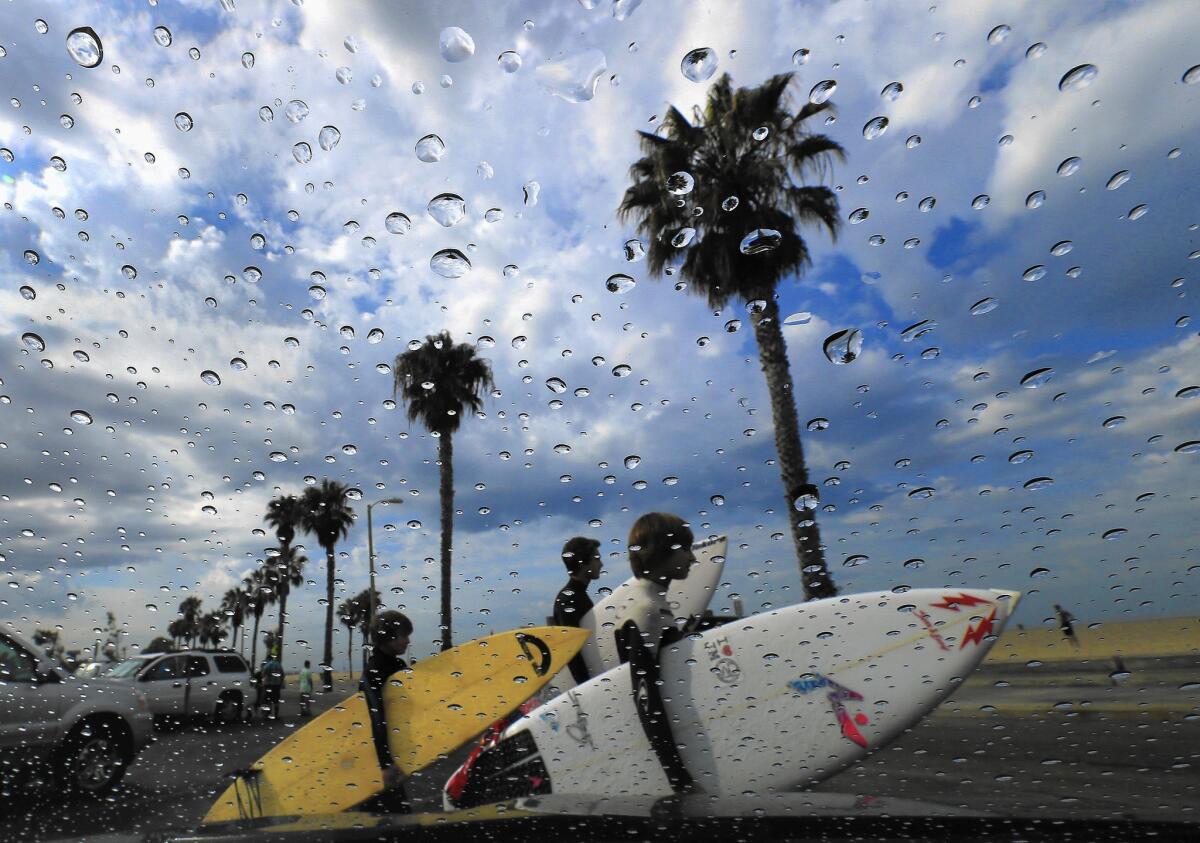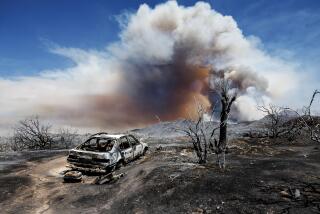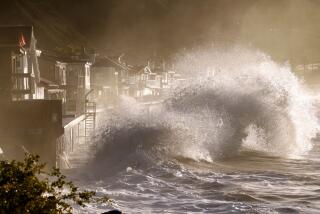July’s record-breaking rainfall may not be over yet

Rain gathers on a windshield and storm clouds roll in as surfers head out to the beach July 18. The surfers ended up turning around and heading home after they were advised by Los Angeles County Fire Department lifeguards that all Los Angeles County beaches were closed.
July — already one of the wettest in California’s history — is expected to go out with one more drenching.
Forecasters say a monsoonal flow could hit Southern California on Wednesday, bringing more rain, thunder, lightning and muggy conditions into the weekend.
The weather, which officials believe is tied to the El Niño system building in the Pacific, has been marked by contradictions.
The rain has helped contain some brush fires and brought a small respite from four years of drought.
At the same time, the storms caused scattered road damage and prompted lifeguards to clear out beaches during the peak summer season as a safety precaution. Last year in Venice, a surfer was struck by lightning and died.
“It’s a bit of a conundrum. You get a lot of rain in a short period of time … and within a week, we’re right back to where we were,” said Gary Wuchner, a fire specialist at Yosemite National Park.
Perhaps nowhere is the dichotomy playing out more than at Yosemite, where last week a storm dropped nearly two inches of rain, reducing the park’s July fire risk to a level not seen in years. At the same time, lightning from the storms sparked about half a dozen wildfires.
“You get this much rain in this short period of time, Yosemite Falls more or less woke up and the rivers rose,” Wuchner said. “You’re up here for so many years, you see what’s going on. It doesn’t take a scientist to see, ‘Wow, we got some water.’ It takes the edge off.”
Last week’s storms were so intense that they caused a mud and rock slide on Highway 140 leading to the park’s western edge.
The debris, which fell from a hillside that burned during the El Portal fire last year, was so extensive that the road — one of only three main routes to the park from the west — remained closed for two days until Thursday evening.
Crews are monitoring about a dozen small lightning-caused fires in the park’s higher elevations. Wuchner said the rain proved to be a remarkable ally, extinguishing nearly half a dozen fires.
Earlier this month, the National Interagency Fire Center in Idaho amended its fire season outlook for Northern California after a series of early July storms.
“These are unusual fuel moisture trends for the time of year, but the result is reduced potential for large fires in the north and east sections” of Northern California, the agency said.
Some fire officials are less optimistic. They say the summer heat immediately kills whatever green shoots sprout up after rain, creating another layer of fuel to burn.
Climatologists believe the rain is the result of El Niño, a weather phenomenon characterized by the warming of Pacific Ocean waters west of Peru that causes changes in the atmosphere and can dramatically alter weather worldwide.
Last week’s rains came from remnants of Hurricane Dolores. Warmer ocean temperatures allowed the former hurricane to make landfall in California with more moisture and strength than if the ocean was as cool as it normally is.
The source of this week’s expected storms is a monsoonal system centered over Arizona and Texas via Mexico, forecasters said.
The unusually warm waters in the Pacific are behaving like a siren for hurricanes off Mexico like Dolores, which drew humid air and punishing thunderstorms north to California, where they’ve slammed head-on with the state’s drought conditions, forecasters say.
“This is certainly the most active [July] I’ve seen since I’ve been here,” said Tom Dang, a meteorologist in the National Weather Service’s Sacramento office for the last seven years.
There’s a favorable chance that this winter will be wetter than average in much of California — from San Diego to San Francisco. The greatest chance for wet conditions is in Southern California, Mike Halpert of the National Oceanic and Atmospheric Administration’s Climate Prediction Center said recently.
But, for now, there’s only an equal chance of a wetter-than-average rainy season north of San Francisco, where much of the state’s water supply is collected and stored in giant reservoirs. California needs both rain and snow up there. Snow slowly melting from the mountains is essential to recharging the reservoirs later in the spring.
A typical El Niño generally dumps heavy rain only on Southern California. But the most powerful El Niños on record, 1982-83 and 1997-98, were strong enough to send dramatic storms over Northern California as well.
This year’s El Niño could be as strong or stronger as the 1997-98 El Niño. On July 22, a key benchmark location in the Pacific Ocean was 2.88 degrees above average. That’s similar to the temperature reading July 23, 1997, which was 3.06 degrees above average.
Typically, winds along the Pacific Ocean at the equator move east to west. That’s why ocean water on Indonesian beaches is so warm. As winds move warm water west, the eastern Pacific Ocean’s surface along the equator is chilled as deep ocean water wells up.
In big El Niño years, the so-called trade winds weaken, allowing the eastern Pacific Ocean to warm up more — making El Niño even stronger.
El Niño can produce heavy precipitation in California by bringing something called the subtropical jet stream over the state.
This current of air usually runs over the jungles of southern Mexico and Nicaragua, a reason Central America has rain forests, said Bill Patzert, climatologist with NASA’s Jet Propulsion Laboratory in La Cañada Flintridge.
The subtropical jet stream has already shifted north and is somewhat responsible for the devastating storms that pelted Texas and Oklahoma this spring and pushed those states out of drought, Patzert said.
“If it continues to warm up in the eastern Pacific, as we get into fall and winter, the subtropical jet stream could move across the southern tier of the United States,” Patzert said.
Twitter: @josephserna
Twitter: @ronlin
ALSO:
Struggle to save endangered Santa Ana sucker may reach U.S. Supreme Court
Hey, California, you can still have a lawn! Here are five water-wise alternatives
It’s critical El Niño hits Northern California. Why experts are growing optimistic.
More to Read
Sign up for Essential California
The most important California stories and recommendations in your inbox every morning.
You may occasionally receive promotional content from the Los Angeles Times.












